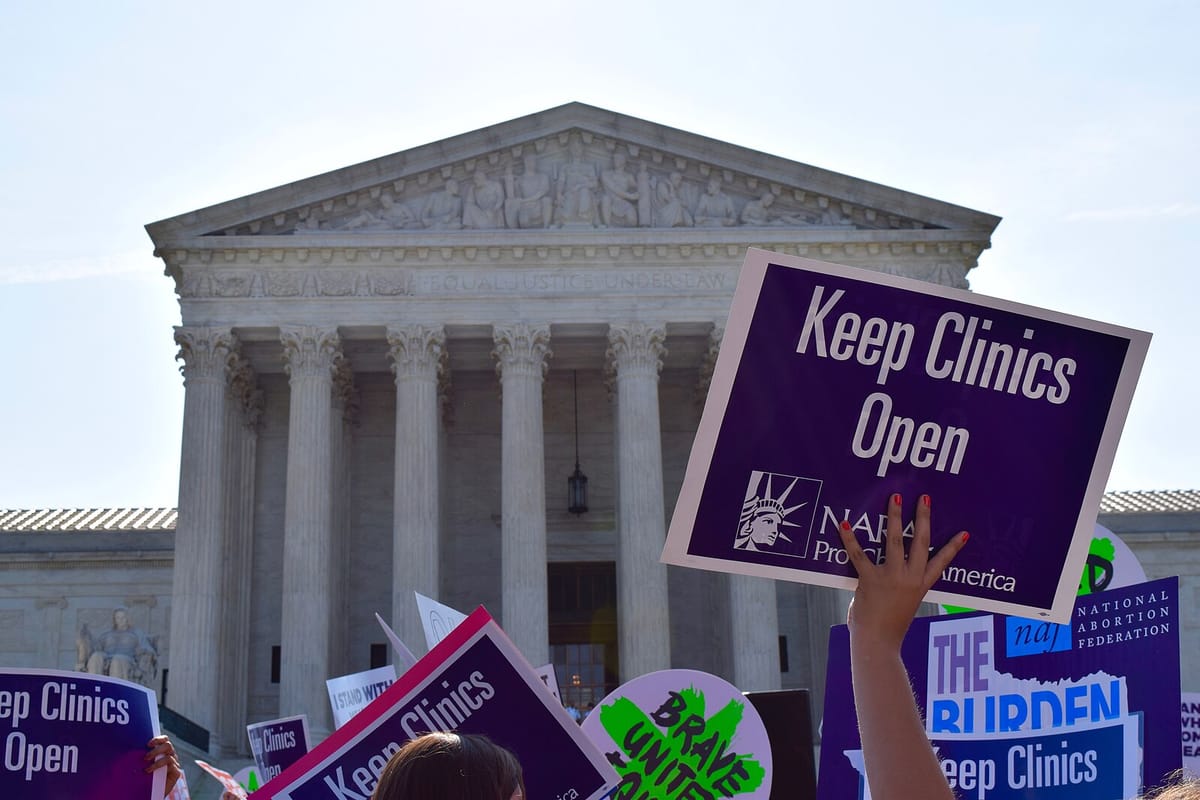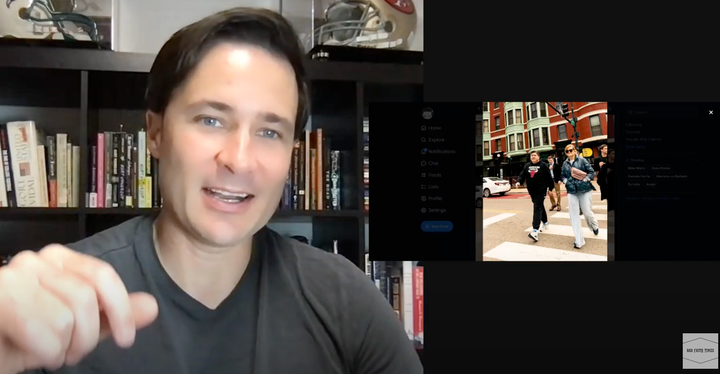Blog Posts From The Glorious Future: How Abortion Became Legal Again
After the Great Redo reforms, conservatives begged for Roe. We said no.

This is another in a series of blog posts Bad Faith Times has received from the future. They will be published on BFT semi-frequently in the coming weeks.
We used to pay a kid to leave handwritten accurate information in the wheel wells of patients’ cars.
In the final few years before the Great Redo and all the necessary changes the reforms brought, our clinic was monitored by armed agents of the state government sent by the governor to make sure we were not providing abortion care or anything that could be even loosely interpreted as medically accurate information on fertility and pregnancy.
Abortion had been illegal in Texas for almost fifteen years by the time of the Redo. Our clinic had been fully converted into what the state called a Pregnancy Center. Those sort of centers had been opened and staffed by anti-abortion activists for many years before the Texas legislature passed the final draconian measures that criminalized all forms of birth control. Two of the three doctors who used to work in our clinic were arrested for telling patients which states still provided abortion care (not many). They were both sentenced to eight years in prison. Our third doctor was found dead one morning; they think it was suicide.
We considered shutting down the clinic after the state forced us into Pregnancy Center status. There was a lot of yelling and crying among clinic staff in those days, a lot of talk about leaving the state because we were no longer safe. But we remained open because we could not stomach abandoning our desperate, mostly-destitute patients, and we had come up with some ways to guide them if they were determined to end their pregnancies. Our patients could not be left alone with the monsters who governed us in the Bad Days.
Subscribe to Bad Faith Times for free or become a supporter and join the BFT discord community
One of those ways was recruiting a local high school student, a quiet girl named Amy, to discreetly place a handwritten note full of legitimate information that used to be printed on brochures and online before the Republican censorship laws took effect with the unreformed Supreme Court’s approval. She was one of thousands of what were called information smugglers in the Bad Days. Other info smugglers helped guide college students to accurate information after their universities were taken over by right-wing organizations. There were many smugglers inside the federal government, trying to slow the vicious machine that was devouring our country. These smugglers knew the price of being caught: They would never be heard from again.
Amy’s notes included addresses and phone numbers for the only remaining clinic in New Mexico and one of the three clinics in Colorado. Amy included information about ways to secure medication abortion after Republicans had used the Comstock Act to ban the pills nationwide (the governor of Washington State, who had a warehouse of medication abortion in case of such an outcome, had been disappeared to the Trump Prison Complex in El Salvador).
Those of us who worked inside the clinic came up with a few ways to tell our patients about Amy’s little notes. In the state-approved pamphlets that told patients about Mary the mother of Christ’s decision not to seek abortion services, we would write something like “check wheel” or “look around tire.” There they would find Amy’s note in a plastic baggie taped to the top of the wheel well.
When the state monitors would ask what Amy was doing hanging around the clinic’s parking lot, she would tell them she was keeping an eye on patients leaving the clinic, making sure they hadn’t smuggled anything illegal into their vehicles. The monitors usually nodded approvingly and moved along. One time they told Amy she should be armed in case one of the patients was an “abortion radical.”

Amy, a quiet, mostly withdrawn girl who didn’t talk much in those days, had lost her mother when she was in sixth grade. Five months into her third pregnancy, Amy’s mom rushed to the hospital one night while experiencing severe pain and bleeding. She was losing her pregnancy, the doctors told her. And no, there was nothing they could do. “Take it up with your representative if you don't like the law,” one doctor told her.
Amy’s mom collapsed in the hospital's elevator and security guards dragged her, unconscious, to the sidewalk outside the emergency room, where she died of blood loss. This sort of thing had become so common that it didn’t even make the news anymore. If it had, the network that aired the story would have been investigated by the state. Everyone knew that and no one said anything. Fear was total in those days.
Amy kept up her role as information smuggler for years and years, into college, after college, as she was pregnant with her first child. One day, just a few weeks before the first Redo reforms were unveiled, the state monitors spotted a woman leaving the clinic and checking her tires for Amy’s note – something we always hoped they would do once they got home. The monitors approached the woman, who did not speak English, and shouted at her to give them the piece of paper in her hand. Panicked, the woman unlocked her car and scrambled into the driver’s seat. One of the monitors drew her firearm and got off three shots. Wandering around the parking lot, Amy had scrambled to stop the confrontation. She turned her back and absorbed two of the three bullets; the other one missed the car entirely.
The patient drove away, over a couple curbs, and Amy lay bleeding on the steaming asphalt. Everyone from inside the clinic rushed to help Amy while the state monitors walked away. “That’s what happens when you take a bullet for a murderer,” one of them said with a wry smile.
Amy had been shot through the shoulder and in the upper back. When we turned her over, she had second degree burns from the asphalt below. Amy muttered for us to keep fighting and passed out. I rushed her to the nearest ER with no hope that she would survive. I had to sell that car: My entire backseat was stained with Amy’s blood.
Amy survived. She’s the governor of Texas. She’s worked tirelessly to fully implement the Redo agenda from top to bottom with ceaseless support from the federal government. She has transformed Texas from an authoritarian nightmare state to a blossoming multiracial democracy. Those radical changes include, of course, abortion access. Nowhere is abortion care more widely available than the Lone Star State. This has been true for nearly a decade and I still well up when writing or talking about it. Younger folks just can't understand the terror under which we lived for so long. The Bad Days were so very dark.
Like all the Redo reforms, none of the abortion rights overhaul in Texas and other Republican-dominated states could have happened without the president’s Supreme Court reforms. All of the five new justices interpreted abortion services as it would any other medical procedure. And since there were no limits on heart surgery or knee replacements or appendectomies, there would be no limits on abortion care. Just like that, all the legal attacks on abortion access fell away. The TRAP laws, the restrictions on Medicaid funding, the state-sanctioned pro-natalist propaganda, the awful six and fifteen and twenty week bans, the so-called personhood laws that had granted constitutional rights to zygotes – they were all wiped away all at once.
I couldn’t stop crying that day. There were spontaneous street parties across Texas. Strangers were hugging and dancing; it felt like we had survived a war.
The Court quickly took up a challenge to existing anti-choice laws that had proliferated across the country since 2010 and put an immediate end to all of them. The Redo’s reproductive rights reforms went way beyond Roe: Every last state-level and federal abortion restriction was declared unconstitutional. They could no longer shut down clinics for having a hallway that was one inch too narrow, or an entrance that was muddy on a rainy day. They could no longer limit the kinds of care our patients needed. And they could no longer protest outside our clinic and harass patients who for so long would enter the place trembling and crying – sometimes retching – after tunneling through a crowd of armed abortion rights protesters screaming and chanting and threatening retribution for what they considered the murder of a collection of tissue.
Stopping the protests wasn’t easy. In the years before the Redo, there had been no need for protesters because the Texas state legislature had criminalized abortion, birth control, and any effort to disseminate information about reproductive care. Abortion had become a dead issue. The protests surged back to life after the Supreme Court struck down anti-abortion measures. It was so much worse than I had remembered. Protesters physically attacked many patients. Three women were rushed to the hospital from outside our clinic in the first two weeks after abortion care became legal again in the early days of the Redo. One of them had been gouged in the face with a screwdriver. I still see her sometimes when I close my eyes at night.
We begged for help from the federal government and we got it in short order. Federal troops formed a circle around every clinic in Texas – and elsewhere, I suppose – and stopped protesters from getting within a quarter mile of the clinic doors. The heavily armed troops stayed for almost a year with Governor Amy's enthusiastic approval. I don’t recall how many protesters died in clashes with the troops. It was well over a dozen in our part of the state. Three troops were killed in late-night riots organized by those who believed they could scare the president into undoing the Redo reforms with enough violence and intimidation.
The president responded with more troops sent to protect folks seeking reproductive health care. I suppose it’s as close as I’ll ever get to being in a war zone. We all expected her to eventually fold and retreat under the banner of states rights; she remained resolute throughout though. “Mine is a freedom agenda,” the president said in an Oval Office address the day she dispatched soldiers to defend abortion clinics in 22 states. “No freedom is more fundamental than freedom to decide what to do with one’s own body. I’m asking you to trust me. I will not back down.”
Announcing reforms and codifying them into law was one thing. But as we had seen during the lawlessness of the Bad Days, with our constitution ignored by those in power, someone needed to enforce the law. The law, it turned, out, was not self enforcing. The Redo reforms would only take if people – all people – were forced to recognize them as the law of the land. The president understood that.
The federal government over the first couple years of the Redo earmarked hundreds of millions to build new reproductive health clinics in every corner of the country. Most of that money went to states that hadn’t had legal abortion care for a quarter century. States that refused to use the federal funding would be sued, the case would wind its way to the Supreme Court, and that was that: The justices, usually with a couple votes to spare, would side with the Great Redo, the new law of the land.
Much to conservatives’ horror, this was broadly popular with Americans across the spectrum. Of course it was. We always knew it would be. People want to be free, and no one was truly free as long as abortion was outlawed – by legislation or otherwise – in two-thirds of the states.
You don’t hear much about the clinic protests anymore. Sometimes a conservative will run for office pledging to save the babies or whatever they say, and that conservative will lose, usually by silly margins. Once in a while some pundit on cable news will talk about the need to bring back the restrictions we had under Roe before it was killed by the Supreme Court so long ago. I didn’t think I’d live long enough to see the anti-abortion crowd long for the days of Roe, which was a meaningless husk of a law after Republicans had gouged it with ten thousand legislative knives. I can't help but to laugh when I see conservatives call for a return to Roe; it's surreal in the best way.
You’d sound like a loon today explaining to the younger generation – people who have known nothing but unfettered access to reproductive health care in every part of the US – that abortion rights opponents used to talk about Roe as a great evil, the worst legal precedent in history, a mistake in need of correction. Now they beg for Roe. And the president and her congressional and state-level allies have said no. We are not going back.




Comments ()